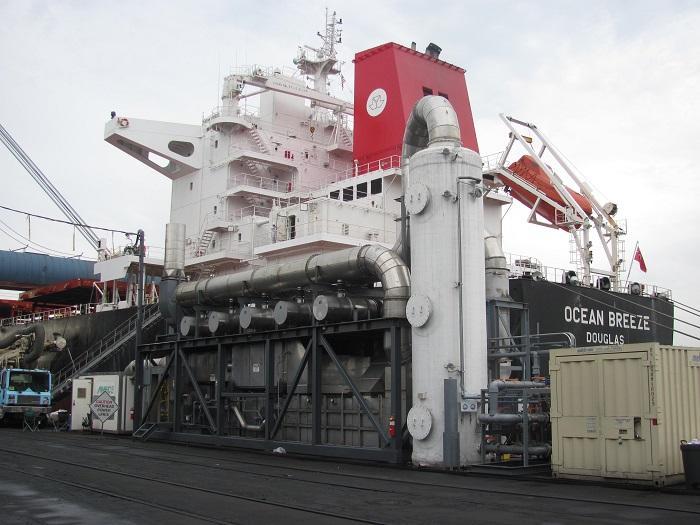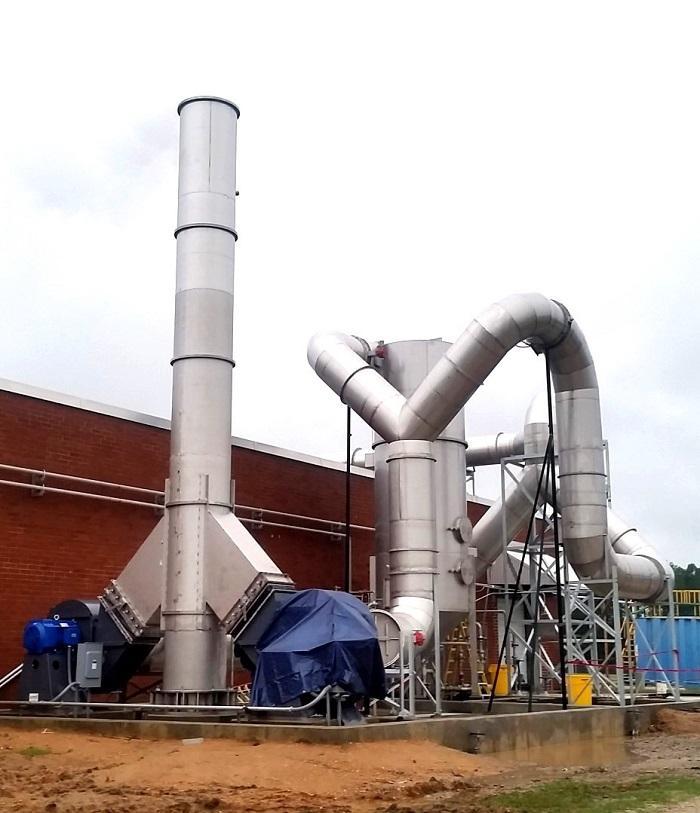Air pollution has been one of the most controversial issues throughout the world which kills an estimated seven million people worldwide every year. WHO data shows that 9 out of 10 people breathe air containing high levels of pollutants. A Scrubber system is one of the most effective devices against these toxic emissions. Therefore, knowing what it is and how it works is a must for companies. Linquip has gathered around all the useful information each company requires to decrease the amount of pollution released through the manufacturing process and burning fossil fuels. Read the article and find out more about it!
What is a Scrubber system?
It is an air pollution control tool that removes chemical or particle waste from polluted gases of industrial exhaust or flue gas streams which are directly harmful to human health. Thus the removal of gas particles causing trouble during the process is necessary before disposing of the gases in the open air. As a matter of fact, scrubbing is an after-treatment method in which the exhaust gas is passed in the column from the downside and scrubbing solution or material is sprayed at the top. In other words, the gas stream is brought into intensive contact with a liquid, with the aim of allowing certain gaseous components to pass from the gas to the liquid. There are some variations in the design of scrubbers, however, the two main types of scrubbers are wet scrubbers and dry scrubbers.
Scrubber working principle
As mentioned above, a scrubber is a cleaning installation with the sole purpose of neutralizing toxic components in industrial air or waste gas streams. The installation operates by bringing a gas stream in contact with a washing liquid. Due to this contact, certain gaseous components dissolve and remain in the water. Then there is a transfer of the components from the gas phase to the liquid phase which is called the absorption process. The solubility of the elements in the liquid will determine to what extent the gaseous components dissolve into the liquid phase. Hence, using the correct fluid as the absorption agent plays a vital role in running a scrubber system. Besides water, several organic or inorganic liquids can also be used as absorption mediums. In many cases, certain chemicals or micro-organisms are added to the scrubbing liquid to convert or neutralize gases that are dissolved in the liquid. As a result of this conversion, the concentration in the water is reduced, which in turn allows more gas to dissolve. The concentration of polluted substances in out-going gas streams can never become lower than permitted by the equilibrium between the gas phase and the scrubbing liquid. It must be noted that using a scrubber in an optimal manner, would lead to a high removal efficiency of harmful emissions.
Scrubber system components
- Fans: Fans in scrubber systems are usually centrifugal. In centrifugal fans, exhaust gas is introduced into the center of a revolving wheel, or rotor, and exits at a right angle (90°) to the rotation of the blades.
- Ducts: Ducts, or ductwork, transport exhaust gas to and from the scrubber. Ducts are carefully designed to keep pressure losses and, consequently, operating costs at a minimum. In general, this requires sizing the duct properly and minimizing the number of bends, expansions, and contractions. Sizing the duct to suit the exhaust stream velocity will also reduce the amount of dust that settles in the ductwork.
- Pumps: A wide variety of pumps are used to transport both the scrubbing liquid and the sludge. The proper choice of a pump depends on flow rate, pressure, temperature, and material being pumped. Electric-motor-driven centrifugal pumps are the pumps most frequently used in scrubber systems.
- Pipes: Pipes transfer liquid to and from the scrubber. As with pumps, pipes are susceptible to abrasion, corrosion, and plugging. Pipes can be made from a wide variety of materials to reduce these problems.
- Quenchers: Occasionally, hot exhaust gas is quenched or cooled by water sprays before entering the scrubber. Hot gases (that are above ambient temperature) are often cooled to near the saturation level. If not cooled, the hot gas stream can evaporate a large portion of the scrubbing liquor, adversely affecting collection efficiency and damaging the scrubber’s internal parts.
- Spray Nozzles: Three different nozzle designs are used to produce a fine, cone-patterned spray. They include an impingement nozzle, a solid cone nozzle, and a helical spray nozzle.
- Entrainment Separators: Entrainment separators, also called mist eliminators, are used to remove liquid droplets prior to exhausting gases to the atmosphere. Although the major function of an entrainment separator is to prevent liquid carryover, it also performs additional scrubbing and recovers the scrubbing liquor which leads to saving on operating costs.

Scrubber Design Considerations
Important design considerations for the scrubber system include the following:
- Pollutant Targeted
- Removal Efficiency
- Process Conditions (i.e. flow rate, temperature, concentration)
It is good to keep in mind that the appropriate contact time between the gas and the scrubbing liquid guarantees effective scrubber removal efficiency achievement.
Products of Scrubbers
The products of scrubber systems can either be hazardous waste products or useful products. In some cases, the scrubber and downstream processing can produce a solid slurry which is isolated from the purified gas. While in most cases, the pollutant product will need to be further processed in order to become a useful end product. Gypsum extracted from scrubbers used in coal power plants is an example of a useful product. This synthetic gypsum can be used as a component of drywall, in agricultural applications, and also in manufacturing portland cement. Companies must be aware of the byproducts of their scrubbers and the way to dispose properly of the toxic waste. Recycling the waste can be a great option to either save on hazardous waste disposal or make money on a byproduct. Secondary processors of scrubber byproducts will actually eliminate the waste and in certain cases pay a price for the slurry.
Advantages of Scrubbers
- It can handle flammable and explosive dust with little risk.
- It provides gas absorption and dust collection in a single unit.
- It is versatile in different sectors like the chemical industry, the pharmaceutical industry, and surface treatment.
- It also provides cooling of hot gases.
- It is compact therefore it can often be retrofitted into existing collection systems.
- By using scrubbers, corrosive gases and dust can be neutralized.
Disadvantages of Scrubbers
- There is a high potential for corrosion problems.
- Collected particulates may be contaminated and unrecyclable.
- Protection against freezing is required. Certain streams may require reheating to avoid visible plumes.
- Disposal of waste sludge can be very expensive.
- In this system, makeup water is required to replace purged liquid and disposed of sludge.
So this is all you need to know about the scrubber system and its components. If you enjoyed your time at linquip and want to share your experience with others, feel free to leave it in the comment section. We will be more than glad to have your viewpoint on the article. If you need any assistance with similar subjects, do not hesitate to sign up on our website where our experts are ready to solve your issue.
Buy Equipment or Ask for a Service
By using Linquip RFQ Service, you can expect to receive quotations from various suppliers across multiple industries and regions.
Click Here to Request a Quotation From Suppliers and Service Providers
Read More on Linquip
- What is an Air Scrubber and How Does it Work?
- Do you know the main types of Scrubber?
- Dry scrubbers: a brief review of everything you need to know about them
- What is Negative Air Pressure: A Complete Guide
- What is Air Pollution? All You Need to Know
- Scrubber system: a must-read for eco-friendly companies!





Wonderful piece of knowledge!!
Dear Krishna
Thanks for your Comment and Attention